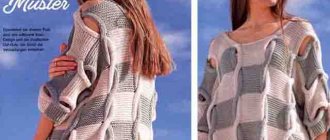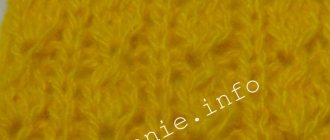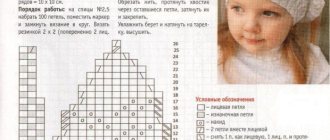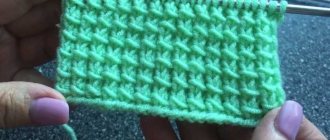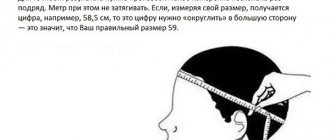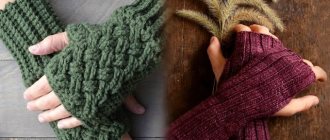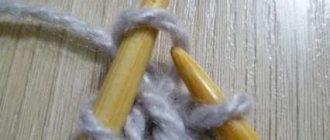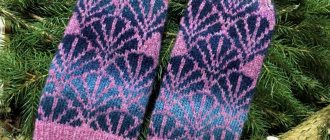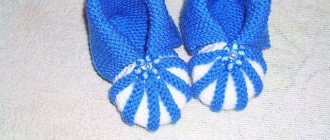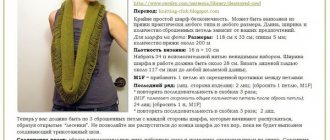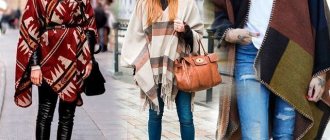Needlework
06/11/2018 Anastasia Prozheva
The herringbone pattern is one of the most versatile knitting techniques. It is suitable for all wardrobe items, from mittens to coats, goes well with other patterns, can serve as a good background for decorative elements, and with the correct selection of size and color scheme it creates a self-sufficient geometric pattern. As a rule, this ornament is associated with winter things, but it also looks good in a light version made of thin threads. There are several different options for knitting the herringbone pattern with knitting needles, which differ in their complexity and delicacy.
Simple option
The easiest version of the herringbone pattern is a one-sided pattern reminiscent of tweed fabric. A description of this technique can be seen below.
When using thick threads, this pattern can be used to knit a thick, warm scarf or hat; it is great for knitting sweaters and coats.
If you want to complicate the task a little, you can use threads of several colors; a gradient, as well as vertical or horizontal contrasting stripes, look good on this pattern. A distinctive feature of these “Christmas trees” is the use of any number of loops. Pattern repeat - two rows.
In the first row, you should tie two loops together at the back walls with one front one. Then one of these loops is removed from the knitting needle, leaving the second. Next, in the same way, you need to knit the next two loops, moreover, one of them is the one that remained from the previous pair. The entire first row is knitted in this way.
In the second row, knitting continues in the same pattern, with one exception - two loops are knitted together purl, not knit.
Knitting the “Herringbone” pattern with knitting needles: a detailed and step-by-step master class
We bring to your attention a detailed and step-by-step description of the process of knitting fabric with a herringbone pattern. Choose the threads and knitting needles that suit your project. Now you can begin the process of knitting fabric with an original pattern.
Cast on any number of stitches on working needles. You can cast on a small number of stitches on the surface of the knitting needles to learn how to create patterns.
First row: edge loop, then knit two loops together behind the back wall of the loop, then drop only one of the two loops from the left knitting needle, the second loop should remain on the knitting needle. Then knit the remaining stitch with the new stitch, knit two together behind the back walls and slip one stitch off the left needle. The second loop should remain for knitting the next two loops. Thus, continue knitting until the end of the row of your fabric. At the end of the row you have one loop left, you need to knit it in the front way.
Second row: similar to the first, but there you knitted the front loops, and in this row you need to form the purl ones. Make an edge loop, then knit two loops together using a purl loop, then drop only one loop from the left knitting needle, out of two, the second loop should remain on the working knitting needle. Then you need to knit it with a new loop, purl two together and again drop one loop from the left working needle. The second remains for knitting the next two loops. At the end of the row you have one loop left, knit it purlwise.
The remaining rows must be knitted, repeating the manipulations of the first and second rows of the fabric. Now your herringbone pattern is ready!
We bring to your attention a master class with a detailed knitting pattern for a double-sided herringbone pattern using knitting needles. The pattern presented to you shows both knit and purl rows of knitting. Front rows - from left to right, purl rows - from right to left. The pattern repeat includes twenty loops in width and twenty-eight rows in height. For symmetry, before rapport, knit nine loops, after repeat, form ten more loops.
In patterns where you need to form yarn overs on the back rows of the garment, knit two or three stitches together. It is also necessary to follow the instructions for knitting these loops. The empty square is the front loop. On the knit rows of your knitting there is a knit stitch, and on the purl rows there is a purl loop. Two knit stitches must be knitted together with a knit stitch slanted to the right. Insert the knitting needle into the second loop and the first loop, starting from the second loop, and knit them together. In purl rows, knit a loop with the same designation as two purl stitches together with a slant to the left. Knit two knit stitches together, slanting to the left. Remove the first loop as in the knitting method, knit the second loop in the knit method and pull the removed loop through it. In purl rows, knit a loop with the same designation as two purl stitches together with a slant to the right. Knit three loops together in a knit stitch with a slant to the left. Remove one loop without knitting, knit the next two loops together behind the front walls, and pull the resulting loop through the removed one. Yarn over
Oblique herringbone
This version of the pattern is also created using only knit and purl stitches, but the pattern ends up being double-sided, so it is well suited for creating scarves and snoods. The repeat of this pattern is 10 loops and 20 rows. All even rows must be knitted according to the pattern, odd rows - in accordance with the pattern, strictly observing the order of the loops.
Related article: How to weave a bracelet from rubber bands on a fork: diagrams with photos and videos
In order to turn a scarf knitted using this technique into a snood, it is necessary to tie the repeat of the pattern to the end, then when the ends of the product are connected, the “herringbones” will coincide. The snood should be connected with a knitted seam, which with such a pattern will be invisible.
Products decorated with such an ornament look strict and restrained, so “Christmas trees” can be used in both men’s and women’s clothing.
Unusual triangular Christmas tree toy
We knit a model of a Christmas tree, which can be given as a gift or used as a beautiful toy for the New Year's holiday. For knitting you will need two colors of yarn, red and green. In addition, we will prepare knitting needles, a hook and any soft filler (you can use synthetic padding). Cast on with 22 P knitting needles and green threads:
Then you need to make the first row (P) with facial loops:
On the reverse side of the work we knit the second row with purl loops:
From the third knit P we begin to work with knitting needles with decreasing stitches, which is performed at the beginning and end of the row. After 2 P are knitted together, you need to knit 1 P with green, and 1 P with red yarn:
Read
Stylish cardigans made from thick yarn: lessons for beginners
In the same R we knit, alternating two green and one red loop. At the end we knit 2 P together, making another decrease:
The next 4th purl P should be knitted only in green, without reducing the number of P:
We continue to knit the fabric of this product with our own hands, decreasing the P along the edges of the front P, and periodically making splashes of red in them:
On the wrong side we do not decrease the loops, but in the knit stitches we insert red thread only at certain intervals:
We knit using this technique until we get this triangular fabric with red dots:
Having finished the first triangle, we will knit another one of the same kind, but without the red inclusions:
When both triangles are ready, you need to connect them together by crocheting. The internal space is filled with padding polyester:
The trunk of the product is also crocheted with single crochets. To do this, you need to knit six single crochets in two rows:
If you sew a thread loop to such a Christmas tree, you can use it as a toy for the New Year.
Openwork option
An openwork herringbone looks better when made from thin threads, thanks to which the pattern remains airy and light. This fabric is suitable for berets, light scarves, pullovers and cardigans. Pattern repeat - 18 loops and 12 rows. The second and all subsequent even rows must be knitted with regular purl stitches. If you want to increase the “Christmas trees”, their number can increase proportionally.
The “herringbones” in this pattern are formed by yarn overs and knit stitches, the “trunks” form three loops knitted together purlwise, the remaining fabric is knitted purlwise. The “trunk” of each Christmas tree in the repeat remains in one place - the tenth loop, and the “branches” form a triangle, tapering upward.
The first row is knitted from one knit stitch, yarn over, two knit stitches, five purl stitches. This is followed by three loops purled together, five more purled, two knitted and one yarn over.
In the third and subsequent odd rows, the yarn overs are gradually shifted, one loop at a time, to the center of the repeat. In addition, the number of purl loops is reduced; the 11th row is knitted only with knit stitches, yarn overs and three purl stitches.
How to knit English faceted rib with knitting needles
This pattern is the most popular and famous all over the world. It is loved for its simplicity and speed. Things knitted with this type are dense, elastic, and hold their shape.
What is it suitable for?
For knitting hats, for knitting scarves, berets, sweaters. This option is suitable for both children's and adult models.
How to knit:
This elastic band is knitted, unlike a simple English elastic band, not like 1 row, one knit one, one purl, but this type is knitted two knits, two purls, i.e. it is knitted like the base of a 2 by 2 elastic
So let's begin. We cast on the knitting needles 18 loops
First row. Knits like a two by two elastic band. Let me remind you how to knit: knit 2, purl 2.
Second row and last row. Knit as follows. Remove the first edge loop.
We knit knit stitches from the bottom row. - 2 times. Then purl as usual.
Then again knit as knit from the bottom row. - 2 times.
Video of the pattern
Difficult terrain
A more complex version of the pattern - embossed herringbones - is knitted on four needles. This pattern is suitable for warm, voluminous sweaters and hats; when knitted with thin threads, the pattern will not hold its shape. Rapport - 6 loops and 8 rows.
In the first four rows, the elements of the pattern will be tilted to the right, in the next - to the left, thus slightly beveled triangles will be formed. Knitting is done in circles. On two knitting needles, you need to cast on a number of loops that is a multiple of 12 using a classic cast-on. The base is knitted with knit stitches, they are distributed over four knitting needles, while tightening the loops so that they are tighter.
Related article: DIY application of autumn leaves for 1st grade children with photos
In the first row, three loops should be knitted, two more should be knitted crossed (behind the front walls). This is followed by a yarn over and one simple knit stitch. After this, the rapport is repeated. In the second row you need to knit two knit stitches, followed by two knit stitches crossed. Then you should make a yarn over and knit two more loops. The third row begins with one front row. Then - two together with one face crossed (also behind the front walls). The row ends with one yarn over and three regular knit stitches.
In the fourth row, first knit two together behind the front walls of the front one crossed, then make a yarn over and knit four front ones. From the fifth row, the pattern elements should tilt to the left. In this row, one regular knit stitch is knitted, then a yarn over is made, and after that two loops are knitted together with a broach. In order to knit such a loop, you need to remove the first one, knit the next one (behind the back wall), and then repeat the first one through the second one. Next, three knit stitches are knitted (each of them is already behind the front wall).
In the sixth row, two knit stitches are knitted and a yarn over is made. Afterwards, two are knitted together with a broach, and the row of three regular knit stitches is completed. In the seventh row you need to knit three knit stitches, make a yarn over and knit two together with a broach. The row ends with two knits. In the eighth row, four knit stitches are knitted, followed by a yarn over, two along with a broach, and the row ends with one knit stitch. This completes the rapport. In the process of knitting on four needles, you will periodically have to remove loops from one to another, so when making this pattern it is especially important not to get tangled in the loops and not to knock off the pattern.
Decorative Christmas tree
An elegant pattern that is ideal for knitting cardigans, jumpers, tops, blouses and other bulky items. The background of this pattern is the stockinette stitch. To knit in the round, all even rows are knitted with knit stitches.
Herringbone pattern - MK:
Pattern repeat: 16 loops; 34 rows.
Knitting pattern in rotating rows and in the round:
The number of loops is a multiple of 16 + 2 edge loops for turning rows.
Preparatory row: purl all stitches.
- ROW 1: knit all stitches.
- 2nd and all even ROWs: purl all stitches for turning rows; All stitches are knitted in the round.
- ROW 3: knit 5; 2 persons together. tilted to the RIGHT (behind the front wall); yarn over FROM YOURSELF; 2 persons; yarn over; 2 persons together. tilted to the LEFT (behind the back wall); 5 persons.
- ROW 5: knit 4; 2 persons together. tilted to the RIGHT; yarn over; 1 person; 2 purl; 1 person; yarn over; 2 persons together. with a tilt to the LEFT; 4 persons
- ROW 7: K3; 2 persons together. tilted to the RIGHT; yarn over; 2 persons; 2 purl; 2 persons; yarn over; 2 persons together. with a tilt to the LEFT; 3 persons
- ROW 9: K2; 2 persons together. tilted to the RIGHT; yarn over; 1 person; 2 persons together. tilted to the RIGHT; yarn over; 2 purl; yarn over; 2 persons together. with a tilt to the LEFT; 1 person; yarn over; 2 persons together. with a tilt to the LEFT; 2 persons
- ROW 11: knit 1; 2 persons together. tilted to the RIGHT; yarn over; 1 person; 2 persons together. tilted to the RIGHT; yarn over; 1 person; 2 purl; 1 person; yarn over; 2 persons together. with a tilt to the LEFT; 1 person; yarn over; 2 persons together. with a tilt to the LEFT; 1 person
- ROW 13: K2 together. tilted to the RIGHT; yarn over; 1 person; 2 persons together. tilted to the RIGHT; yarn over; 2 persons; 2 purl; 2 persons; yarn over; 2 persons together. with a tilt to the LEFT; 1 person; yarn over; 2 persons together. with a tilt to the LEFT.
- ROW 15: K2; 2 persons together. tilted to the RIGHT; yarn over; 1 person; 2 persons together. tilted to the RIGHT; yarn over; 2 purl; yarn over; 2 persons together. with a tilt to the LEFT; 1 person; yarn over; 2 persons together. with a tilt to the LEFT; 2 persons
- ROW 17: knit 1; 2 persons together. tilted to the RIGHT; yarn over; 1 person; 2 persons together. tilted to the RIGHT; yarn over; 1 person; 2 purl; 1 person; yarn over; 2 persons together. with a tilt to the LEFT; 1 person; yarn over; 2 persons together. with a tilt to the LEFT; 1 person
- ROW 19: K3; 2 persons together. tilted to the RIGHT; yarn over; 2 persons; 2 purl; 2 persons; yarn over; 2 persons together. with a tilt to the LEFT; 3 persons
- ROW 21: K2; 2 persons together. tilted to the RIGHT; yarn over; 1 person; 2 persons together. tilted to the RIGHT; yarn over; 2 purl; yarn over; 2 persons together. with a tilt to the LEFT; 1 person; yarn over; 2 persons together. with a tilt to the LEFT; 2 persons
- ROW 23: knit 4; 2 persons together. tilted to the RIGHT; yarn over; 1 person; 2 purl; 1 person; yarn over; 2 persons together. with a tilt to the LEFT; 4 persons
- ROW 25: K3; 2 persons together. tilted to the RIGHT; yarn over; 2 persons; 2 purl; 2 persons; yarn over; 2 persons together. with a tilt to the LEFT; 3 persons
- ROW 27: knit 5; 2 persons together. tilted to the RIGHT; yarn over; 2 purl; yarn over; 2 persons together. with a tilt to the LEFT; 5 persons.
- ROW 29: knit 4; 2 persons together. tilted to the RIGHT; yarn over; K1; p2; 1 person; yarn over; 2 persons together. with a tilt to the LEFT; 4 persons
- ROW 31: K7; 2 purl; 7 persons.
- ROW 33: K5; 2 persons together. tilted to the RIGHT; yarn over; 2 purl; yarn over; 2 persons together. with a tilt to the LEFT; 5 persons.
